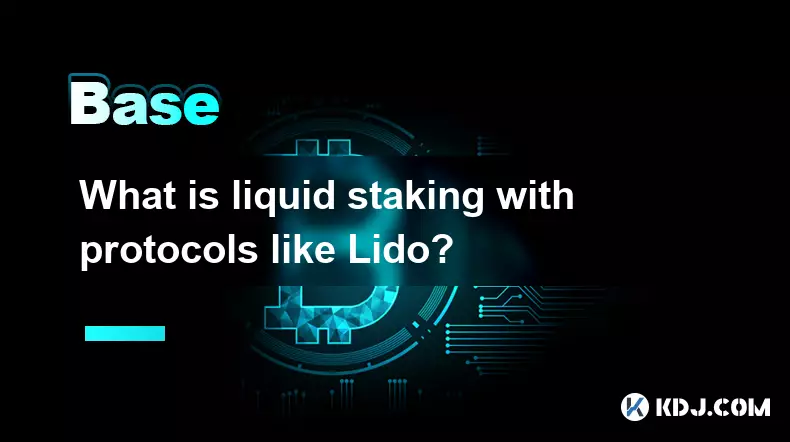-
 bitcoin
bitcoin $108842.957301 USD
-1.88% -
 ethereum
ethereum $3931.777121 USD
-1.66% -
 tether
tether $1.000186 USD
-0.03% -
 bnb
bnb $1153.250882 USD
-2.20% -
 xrp
xrp $2.367904 USD
-1.94% -
 solana
solana $186.182050 USD
-4.20% -
 usd-coin
usd-coin $0.999997 USD
0.00% -
 tron
tron $0.316949 USD
-1.00% -
 dogecoin
dogecoin $0.190780 USD
-3.12% -
 cardano
cardano $0.651324 USD
-2.67% -
 hyperliquid
hyperliquid $37.141055 USD
-0.85% -
 ethena-usde
ethena-usde $0.999224 USD
-0.09% -
 chainlink
chainlink $17.579031 USD
-2.47% -
 bitcoin-cash
bitcoin-cash $509.426284 USD
-2.79% -
 stellar
stellar $0.315298 USD
-2.93%
What is liquid staking with protocols like Lido?
Liquid staking lets users earn staking rewards while maintaining liquidity via tokens like stETH, enabling participation in DeFi without locking up capital.
Oct 13, 2025 at 01:18 pm

Liquid Staking and Its Role in the Blockchain Ecosystem
1. Liquid staking allows users to stake their cryptocurrency while retaining liquidity through derivative tokens. In traditional staking, assets are locked, preventing users from trading or using them elsewhere. With liquid staking, when a user stakes tokens like ETH, they receive a tokenized representation such as stETH from Lido. This token maintains a 1:1 peg with the staked asset and can be freely transferred, traded, or used in DeFi applications.
2. Protocols like Lido abstract away the technical complexity of staking. Running a validator node on Ethereum requires 32 ETH and constant maintenance. Most retail investors lack either the capital or the technical know-how. Lido pools deposits from multiple users, enabling participation without individual node operation. This lowers entry barriers and increases network decentralization over time by distributing staking power more evenly.
3. The received liquid staking tokens accrue value as staking rewards are compounded automatically. For example, stETH gradually increases in ETH value relative to ETH itself because it reflects accumulated staking yield. This mechanism enables passive income without sacrificing flexibility. Users can hold stETH in wallets, provide it as liquidity in AMMs, or use it as collateral for borrowing other assets.
4. Security is maintained through smart contract audits and decentralized node operator selection. Lido does not control all validators; instead, it distributes validation duties across a permissioned set of professional operators vetted by the DAO. This reduces centralization risks while ensuring high uptime and performance. Governance decisions, including fee adjustments and operator additions, are voted on by token holders.
Advantages of Using Lido for Liquid Staking
1. Increased capital efficiency is a primary benefit of using Lido. Instead of immobilizing funds, users deploy staked assets across various financial primitives. A single stETH position can simultaneously earn staking rewards, generate trading fees in a liquidity pool, and serve as collateral in lending protocols. This multi-layered utility enhances overall yield potential far beyond native staking returns.
2. Seamless integration with major DeFi platforms amplifies usability. stETH is accepted on leading exchanges like Curve, Uniswap, and Aave. It powers leveraged yield strategies where users borrow against stETH to restake, compounding gains. These advanced tactics attract sophisticated investors seeking optimized exposure to Ethereum's consensus layer.
3. Transparent reward distribution ensures fairness. Rewards are calculated algorithmically and reflected in the changing exchange rate between stETH and ETH. No manual claims or complex withdrawal processes are required. The system operates continuously, crediting growth directly to token balances in real time.
4. Community-driven governance fosters long-term alignment. LDO token holders propose and vote on upgrades, treasury allocations, and risk parameters. This democratic structure prevents unilateral control and encourages sustainable protocol evolution. Operator performance is regularly reviewed, allowing underperforming validators to be replaced.
Risks and Considerations in Liquid Staking
1. Smart contract vulnerabilities pose an inherent threat. Despite rigorous audits, bugs may exist in the codebase that could lead to fund loss. Historical exploits in other DeFi projects underscore the importance of caution. Lido mitigates this through ongoing security reviews and insurance mechanisms funded by protocol revenue.
2. Slashing risks are passed through to stakers. If a validator behaves maliciously or goes offline, penalties reduce the underlying ETH balance. Since stETH represents a share of the total staked pool, all token holders experience proportional dilution. While rare, these events impact net returns and require monitoring of operator reliability.
3. Centralization concerns arise due to reliance on a limited number of node operators. Although Lido uses a rotating set of vetted entities, the selection process is not fully open. Critics argue this creates a bottleneck that could be exploited under extreme scenarios. Ongoing efforts aim to expand geographic and operational diversity to minimize single points of failure.
4. Oracle dependency introduces another vector of risk. Accurate reporting of staking rewards and exchange rates depends on external data feeds. Manipulation or downtime of these sources could distort valuations and trigger cascading liquidations in integrated lending markets. Redundant oracle networks help reduce this exposure.
Frequently Asked Questions
What happens to stETH during an Ethereum hard fork?In the event of a contentious fork, Lido’s governance may decide which chain to support. Historically, protocols have followed the majority consensus. Users retain ownership of staked assets on both chains but must wait for official protocol direction before accessing mirrored tokens.
Can stETH be redeemed directly for ETH?Currently, redemption is subject to Ethereum’s withdrawal queue post-merge. Lido does not offer instant unstaking but facilitates exit via secondary markets. Once withdrawals are enabled, users can burn stETH to initiate ETH release, pending network confirmation times.
How are staking rewards distributed?Rewards increase the ratio of stETH to ETH over time. Holding stETH in any wallet automatically captures yield as the token’s internal price adjusts. There is no need to claim or reinvest—the accrual is continuous and reflected in all balances.
Is Lido compatible with hardware wallets?Yes, stETH can be stored in popular hardware wallets like Ledger and Trezor. Users interact with Lido’s interface through connected dApps while maintaining custody. Transaction signing occurs offline, preserving security standards.
Disclaimer:info@kdj.com
The information provided is not trading advice. kdj.com does not assume any responsibility for any investments made based on the information provided in this article. Cryptocurrencies are highly volatile and it is highly recommended that you invest with caution after thorough research!
If you believe that the content used on this website infringes your copyright, please contact us immediately (info@kdj.com) and we will delete it promptly.
- Cardano, TRON, and MAGACOIN: Navigating the Crypto Landscape in 2025
- 2025-10-17 08:45:15
- Dogecoin's Next Move: Navigating Crypto Market Turbulence
- 2025-10-17 08:25:12
- Bitcoin Price OKX: Decoding Market Sentiment in Real-Time
- 2025-10-17 08:25:12
- Cryptocurrencies, Mortality, and Digital Economies: Are Your Tokens Alive?
- 2025-10-17 08:30:01
- YGG Play's Launchpad: A New Hub for Web3 Gaming and the Expanding Yield Guild Games Ecosystem
- 2025-10-17 08:30:01
- XRP: Institutional Demand Overpowers Retail Fear?
- 2025-10-17 08:45:15
Related knowledge

How do decentralized identity (DID) solutions work?
Oct 14,2025 at 11:36pm
Understanding Decentralized Identity in the Blockchain Ecosystem1. Decentralized identity (DID) solutions are built on blockchain networks, allowing i...

What is the difference between Near Protocol and Ethereum?
Oct 15,2025 at 08:01am
Near Protocol and Ethereum: Core Architectural Differences1. Near Protocol operates on a sharded blockchain architecture known as Nightshade, which al...

What does it mean for code to be "open source" in crypto?
Oct 12,2025 at 01:54pm
Understanding Open Source in the Cryptocurrency Ecosystem1. In the context of cryptocurrency, open source refers to software whose code is publicly ac...

What is the purpose of a "testnet"?
Oct 12,2025 at 09:01am
Understanding the Role of Testnets in Blockchain Development1. A testnet serves as a parallel version of a blockchain network, designed specifically f...

How to avoid phishing scams in crypto?
Oct 13,2025 at 06:18pm
Understanding Common Crypto Phishing Tactics1. Cybercriminals frequently use fake websites that mirror legitimate crypto exchanges or wallet platforms...

What is the difference between single-collateral and multi-collateral Dai?
Oct 12,2025 at 05:18pm
Understanding Single-Collateral Dai1. Single-Collateral Dai (SCD) was the original version of the Dai stablecoin launched by MakerDAO in 2017. It allo...

How do decentralized identity (DID) solutions work?
Oct 14,2025 at 11:36pm
Understanding Decentralized Identity in the Blockchain Ecosystem1. Decentralized identity (DID) solutions are built on blockchain networks, allowing i...

What is the difference between Near Protocol and Ethereum?
Oct 15,2025 at 08:01am
Near Protocol and Ethereum: Core Architectural Differences1. Near Protocol operates on a sharded blockchain architecture known as Nightshade, which al...

What does it mean for code to be "open source" in crypto?
Oct 12,2025 at 01:54pm
Understanding Open Source in the Cryptocurrency Ecosystem1. In the context of cryptocurrency, open source refers to software whose code is publicly ac...

What is the purpose of a "testnet"?
Oct 12,2025 at 09:01am
Understanding the Role of Testnets in Blockchain Development1. A testnet serves as a parallel version of a blockchain network, designed specifically f...

How to avoid phishing scams in crypto?
Oct 13,2025 at 06:18pm
Understanding Common Crypto Phishing Tactics1. Cybercriminals frequently use fake websites that mirror legitimate crypto exchanges or wallet platforms...

What is the difference between single-collateral and multi-collateral Dai?
Oct 12,2025 at 05:18pm
Understanding Single-Collateral Dai1. Single-Collateral Dai (SCD) was the original version of the Dai stablecoin launched by MakerDAO in 2017. It allo...
See all articles










































































